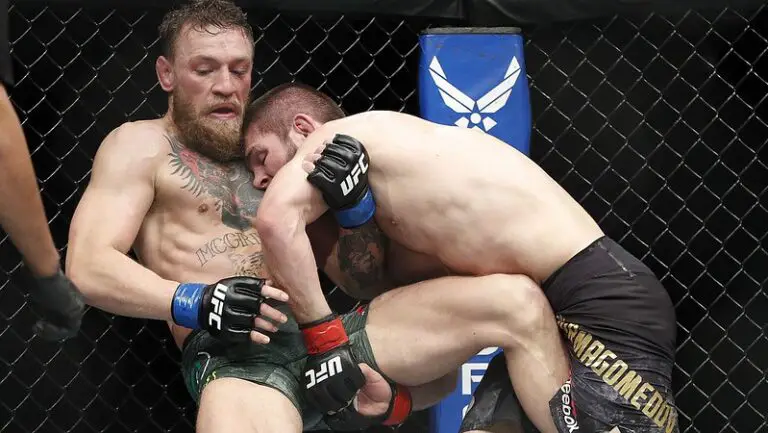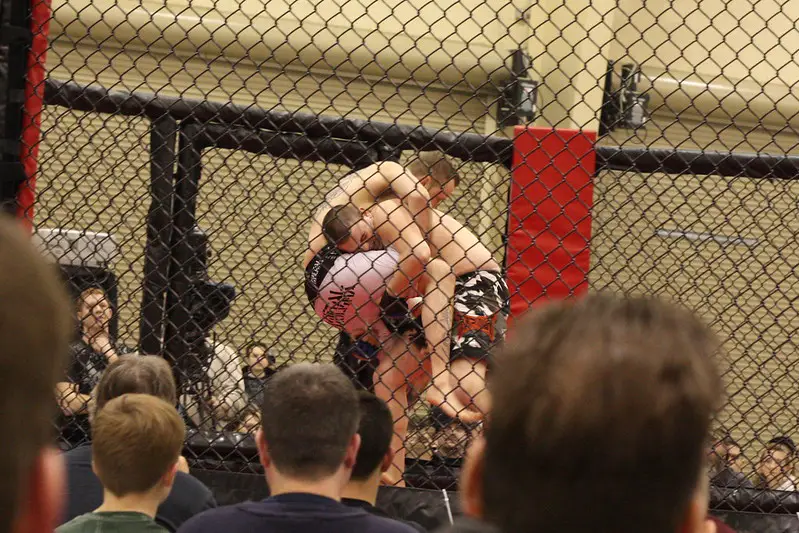Being a UFC fan is hard at times as you often need to wait a year or more before you can see your favorite fighter compete again. This probably makes you wonder, how often do UFC fighters fight?
Why do they compete so rarely?
How Many Times UFC Fighters Fight Per Year?
UFC fighters generally fight between 2 to 5 times per year. Champions and top contenders fight about twice per year, while lower and mid-tier fighters compete 3 to 5 times per year.
Due to the high stakes, they avoid short-notice fights and prioritize full training camps to ensure they are fully prepared and minimize risks. This is notably true for fighters who tend to methodically build their careers. These fighters typically compete twice per year on average.
The story is different for low-tier fighters. They are more likely to take fights on short notice and have less downtime between bouts as they work to climb the ranks and become more popular. These fighters tend to fight more often, averaging between 3 and 5 times per year.
Top-level fighters like champions must balance staying active to maintain their ranking and title status while ensuring they are prepared for each fight to avoid destroying their career with a single loss.
Why UFC Fighters Do Not Compete More Often?
The main reasons are the frequent injuries, weight cutting process, suspensions, and contract disputes. Here is a detailed explanation.
Injuries
Fighting in the UFC is physically demanding and often results in injuries. Fighters can suffer from broken bones, torn ligaments, concussions, and other serious conditions that require extensive recovery time. Even minor injuries can necessitate a few months of rest and rehabilitation. This healing process limits how often fighters can safely compete.
Contract Disputes
Contractual issues also contribute to the infrequency of fights. Negotiations over pay, fight terms, and contract length can become contentious, sometimes leading to prolonged periods where fighters are unable or unwilling to compete.
Disagreements between fighters and the UFC over compensation or contract extensions can sideline fighters for extended durations.
Weight Cutting
Weight cutting is another critical factor. Fighters often undergo drastic weight cuts to compete in specific weight classes.
This process can be gruelling and requires careful management to avoid severe health risks. After a fight, many fighters need time to recover from the physical strain of weight cutting, which can limit their ability to compete frequently.
Suspensions
Suspensions, whether due to failed drug tests, breaches of conduct, or medical suspensions after a fight, can also keep fighters out of the octagon. Regulatory bodies impose these suspensions to ensure fighter safety and maintain the integrity of the sport. The duration of suspensions varies but can significantly reduce the number of fights a competitor can take part in each year.
Obligations Outside of the UFC
Many fighters have commitments outside of their fighting careers that can limit their availability. These can include coaching, running businesses, engaging in media and promotional activities, or personal endeavours such as pursuing education or family commitments. Balancing these obligations with a professional fighting career often necessitates fewer fights each year to maintain overall well-being and long-term career sustainability.
In summary, injuries, contract disputes, the demands of weight cutting, suspensions, and outside obligations all play significant roles in why UFC fighters compete so rarely.
How Long UFC Fighters Prepare For a Fight?
UFC fighters typically prepare for a fight with a training camp that lasts 6 to 12 weeks. This period allows them to get in peak physical condition, develop strategies, and ensure they are fully prepared for their opponent.
In the early weeks, fighters emphasize building strength and endurance. As the camp progresses, they shift focus to sparring, drilling specific techniques, and simulating fight conditions.
In the final weeks, however, they concentrate on fine-tuning their skills and cutting weight to meet their division’s requirements. This comprehensive preparation helps fighters perform at their best when they step into the Octagon.
How Many UFC Events Are There Every Year?
The UFC typically holds around 42 to 45 events per year. These events include a mix of Pay-Per-View (PPV) cards, Fight Nights, and special events. The exact number can vary slightly from year to year based on the organization’s schedule and any adjustments they make.
PPV events usually have a higher-profile card, often headlined by championship bouts or highly anticipated matchups and typically include 12 to 14 fights. Fans must purchase these events to watch them live, which contributes to their higher production value and marketing.
Fight night events feature up-and-coming fighters, prospects, and established fighters not in title contention. They can still have exciting and significant fights but usually do not include as many high-profile bouts as PPVs.
These events are broadcast on cable TV or streaming services, making them more accessible to a broader audience without the need for an additional purchase.
How Long Do UFC Fighters Have to Wait Between the Fights?
UFC fighters typically have to wait several months between fights. However, this wait time varies based on several factors.
If UFC fighters emerge from a bout without any damage or injuries, the commission allows them to compete again after at least 7 days. However, if they get knocked out or choked unconscious, they must follow a strict recovery protocol before returning to the octagon.
After a fight, many fighters need a significant recovery period to heal from injuries, both minor and severe. This recovery time is crucial to ensure they return to peak physical condition.
Next, fighters usually undergo an extensive training camp before each bout, lasting 8 to 12 weeks. During this period, they focus on conditioning, strategy, and honing their skills. Therefore, the training camp itself adds a substantial amount of time between fights.
Contractual negotiations can also play a role. Fighters and the UFC often engage in discussions regarding pay and fight terms, which can prolong the time between bouts if negotiations take longer than expected.
Lastly, weight-cutting requires careful management. Fighters often need time to safely cut weight before a fight and then recover afterward. This process, combined with recovery and training, lengthens the intervals between fights.
UFC Fighters with Most Fights and Wins in a Year?
Some fighters have achieved remarkable records for the most fights and wins within a single year. Here are a few notable examples:
Most Fights in a Year
- Donald “Cowboy” Cerrone — Known for his active fighting schedule, Cerrone fought six times in 2011, which is one of the highest numbers of fights in a year for a UFC fighter.
- Sam Alvey — Another highly active fighter, Alvey fought five times in both 2016 and 2018.
Most Wins in a Year
- Roger Huerta — In 2007, Huerta achieved five wins within a single calendar year, setting a record for the most victories in one year.
- Neil Magny — In 2014, Magny also secured five wins, matching Huerta’s record for the most wins in a year.
These fighters exemplify the rigorous schedules and remarkable durability required to compete multiple times and achieve numerous victories within a year in the UFC.
Can a UFC Fighter Refuse to Fight?
Yes, a UFC fighter can refuse to fight. Fighters may decline a bout for several reasons.
Firstly, they might have concerns about timing. If the proposed fight date conflicts with their recovery period from a previous bout or a training camp, they might opt to wait for a better-suited schedule.
Also, fighters may reject matchups based on strategic considerations. They often aim to climb the rankings or secure a title shot, so they might turn down opponents who don’t align with their career goals.
Contractual disputes also play a role. If fighters feel the financial terms are inadequate or if there’s a disagreement over contract extensions, they might refuse to fight until the issues are resolved.
Furthermore, health and safety concerns are paramount. Fighters may decline bouts if they believe the matchup poses undue risk or if they’re not fully prepared due to insufficient training time.
The UFC understands and respects these decisions and will present another offer once the fighter resolves their issues. Valid reasons for declining a fight include:
- Dealing with personal issues such as a divorce, the loss of a loved one, or other significant life events.
- Being out of shape and lacking sufficient time to train and prepare for the fight.
- Needing to focus on recovering from injuries or undergoing surgery.
However, the UFC takes a different approach if a fighter refuses a bout for what they consider illegitimate reasons. Examples of illegitimate reasons for refusing a fight include:
- Demanding more money than the UFC believes they are worth.
- Declining a fight because they dislike the opponent or doubt their chances of winning.
How Often Do UFC Fighters Train?
Typically, fighters train six days a week, often two or three times a day while in a training camp. They split their training into various sessions that cover different aspects of mixed martial arts, including striking, grappling, wrestling, and conditioning.
Outside of training camp
When they are not preparing for a fight, most UFC fighters train a couple of times a week to stay in shape. The majority uses this time to work on improving their techniques, learning new moves and managing their weight.
During training camp
During a training camp, which typically lasts 8 to 12 weeks leading up to a fight, the intensity and focus of training increase. Fighters work closely with coaches to develop fight strategies, improve weaknesses, and perfect their game plan for the upcoming bout.
They also pay close attention to nutrition and recovery, ensuring they can train effectively without risking injury.
In the morning, a fighter might focus on strength and conditioning exercises, such as weightlifting, cardio, and agility drills. These sessions aim to build endurance, strength, and overall fitness.
In the afternoon or evening, fighters usually engage in technical training. This includes practising specific techniques in disciplines like Muay Thai, Brazilian Jiu-Jitsu, and boxing, as well as sparring sessions to simulate real fight scenarios.
Rest and recovery are crucial components of a fighter’s training regimen. Fighters usually take one day off per week to allow their bodies to recover and prevent overtraining. Additionally, they might incorporate activities like yoga, stretching, and massage therapy to aid in recovery and maintain flexibility.


